Two new bird species discovered nesting in restored Arkansas wetlands
ON 07-15-2020
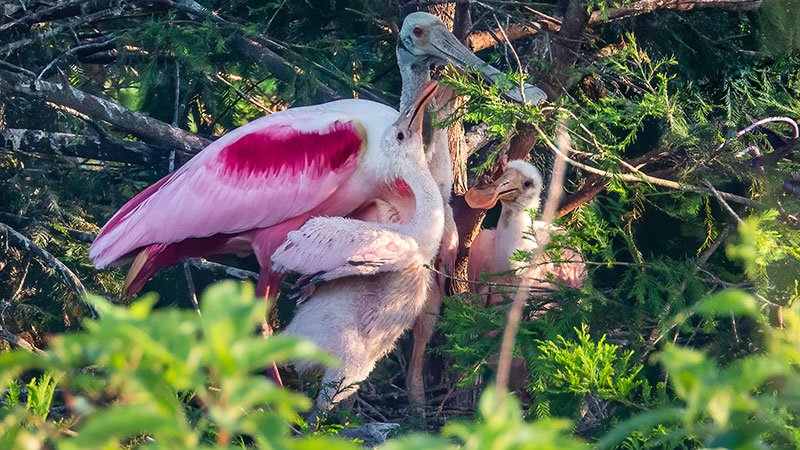
July 15, 2020
Randy Zellers
Assistant Chief of Communications
CROSSETT — After 37 years working at the Arkansas Game and Fish Commission, you’d think Karen Rowe who heads up the agency’s nongame migratory bird program had seen it all, but nothing could have prepared her for the sight introduced to her by a photographer in Ashley County a few weeks ago. Jami Linder, a local nurse and avid turkey hunter turned wildlife photographer took Rowe to some private land that was nothing short of Rowe’s “field of dreams” after the two met from a Facebook group posting to confirm two never-before occurrences in Arkansas.
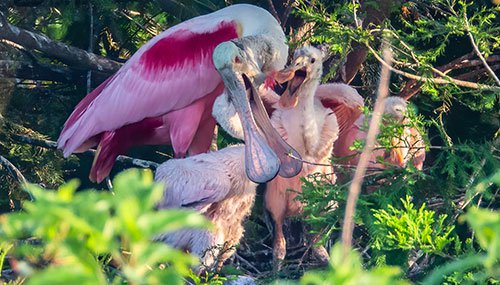
“For the first time ever, we’ve been able to document roseate spoonbills and white-faced ibis successfully nesting in Arkansas,” Rowe said. “To have something like this happen is rare, but after seeing the location where the birds were found I’m just in awe of the multitudes and variety of birds using this area as a nesting ground.”
Linder says she was invited to take pictures of the area after her father and a friend, both of whom were trappers, had been asked to help control a beaver population on the property that is managed with the Wetland Reserve Program as waterfowl habitat.
“They mentioned to the owner about me being a photographer,” Linder said. “He told them to have me come out to take pictures of his birds if I was interested. Daddy said he had roseate spoonbills, and I asked if he was sure. I’m an emergency room nurse, and we have been told to self-quarantine when we are not at work, so I’ve had a lot of time to get out and explore. I’ve spent days out there since then taking pictures of all the wonderful birds that come to roost there. It’s a genuine rookery.”
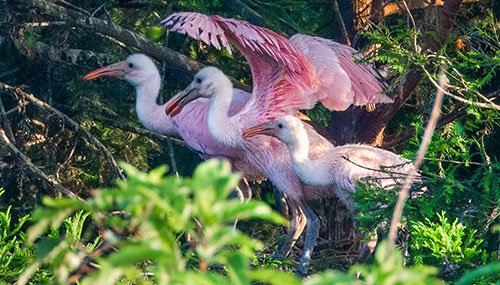
Roseate spoonbills often are found in coastal marshes and wetlands, and usually are only found in the southernmost reaches of Arkansas for a few months of the year before heading back to tropical locations further south. People sometimes confuse them with flamingos from afar, but their distinctive spoon-shaped bills give them away quickly as something different.
“Those bills are actually very sensitive and they used them to probe around in the marsh to feel for crayfish and other invertebrates they eat,” Rowe said. “They have never been documented nesting and raising young in Arkansas, until now.”
Rowe says the discovery came after Linder posted images of the spoonbills on the Arkansas Wildlife Facebook group. After seeing the birds, she reached out to Linder to ask if she knew of any nesting activity.
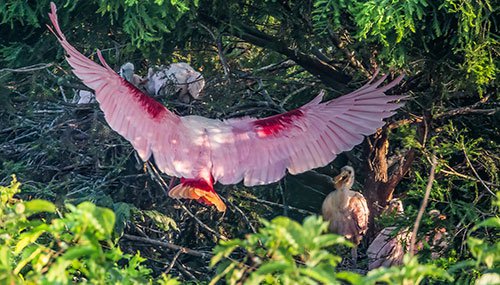
“Karen asked me if I had noticed any nesting activity. I told her all the other birds there were nesting but couldn’t say I had specifically seen any indication the spoonbills were. I had learned through research the spoonbills were in their breeding plumage so I felt chances were good,” Linder said. “When I went through some of my photos, I could make something out that looked like a spoonbill on a nest deeper in the cypress where they were roosting, but I wanted to go back and confirm it.”
After another trip and many more hours in the marsh, Linder came back with shots of not only nesting birds, but young spoonbills that had already hatched. Other photos she has collected since that trip include images of white-faced ibis, another Arkansas rarity.
Linder told Rowe the owner of the property’s name, and as it turns out Rowe had worked with this particular landowner before, so getting an invite to see the land up close was possible. After a daytime visit, Linder suggested the two come back toward sundown when she had witnessed all the birds coming in to roost.
“I’ve been at [Arkansas Game and Fish Commission] for 37 years, and people can be pretty prone to exaggeration,” Rowe said. “But I don’t think there are words that will explain the sight we witnessed last night. There were at least 11 different species of wading birds filling the sky. They were coming into roost so tightly that you had herons, egrets, ibis and anhingas all roosting right next to and almost on top of each other. ‘Awe-inspiring’ doesn’t even begin to do it justice.”
Among the thousands of birds on the area, Linder and Rowe were able to spot about 32 roseate spoonbills, with 20 or so adults, eight in the nest and four learning to fly.
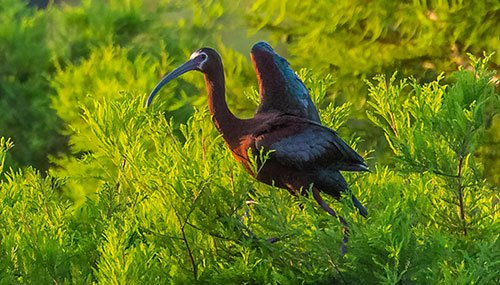
“The adults will feed them a little, then jump to a branch a little bit away, encouraging the young to follow,” Linder said. “It’s just fun to sit there and watch them.”
Trudging through summer swamps may seem insane, but it’s something very familiar to Rowe. The sights can be very enjoyable and worth the effort.
“It’s quite comical to see them actually,” Rowe said. “Usually females and young will be somewhat camouflaged, but these little guys stand out like a sore thumb. They look like Pepto Bismol pink fluffballs in the marsh.”
In addition to the spoonbills, about 60 white-faced ibis were spotted, including some that were, in fact, nesting.
“They’re usually found in coastal Texas and Louisiana,” Rowe said. “But they were here, and they were successful in fledging young as well.”
The ibis and spoonbills were not alone. Herons, anhingas, egrets and many other birds were using the same area.
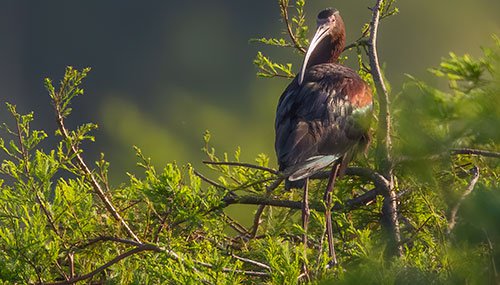
“Humbling, that’s what it was,” Rowe said. “To see all these birds so tightly together using this habitat to nest and feed. I spent so much of my time looking up for the next bird coming in that it got hard to document it all.”
Linder agreed, “It’s just like you stepped into a theater.”
Rowe says this location may not be the only one of its kind in Arkansas in regards to the spoonbills.
“In May I visited a reservoir owned by former commissioner Rick Hampton, and confirmed the presence of both roseate spoonbills and white-faced ibis in breeding plumage,” Rowe said. “It’s also managed for waterfowl habitat and is closely protected from excessive disturbance in the summer. Water and weather patterns are shifting, and these occurrences may just be an indicator of some of the ways nature is responding to those changes. But the real factor at play in these areas is management under the NRCS Wetland Reserve Program that has matured to the point that they are producing the foods that wading birds need to breed and raise young. Without the NRCS Wetland Reserve Program lands, it’s highly unlikely Arkansas would have the habitat needed to support two new species of breeding wading birds.”
Recent News
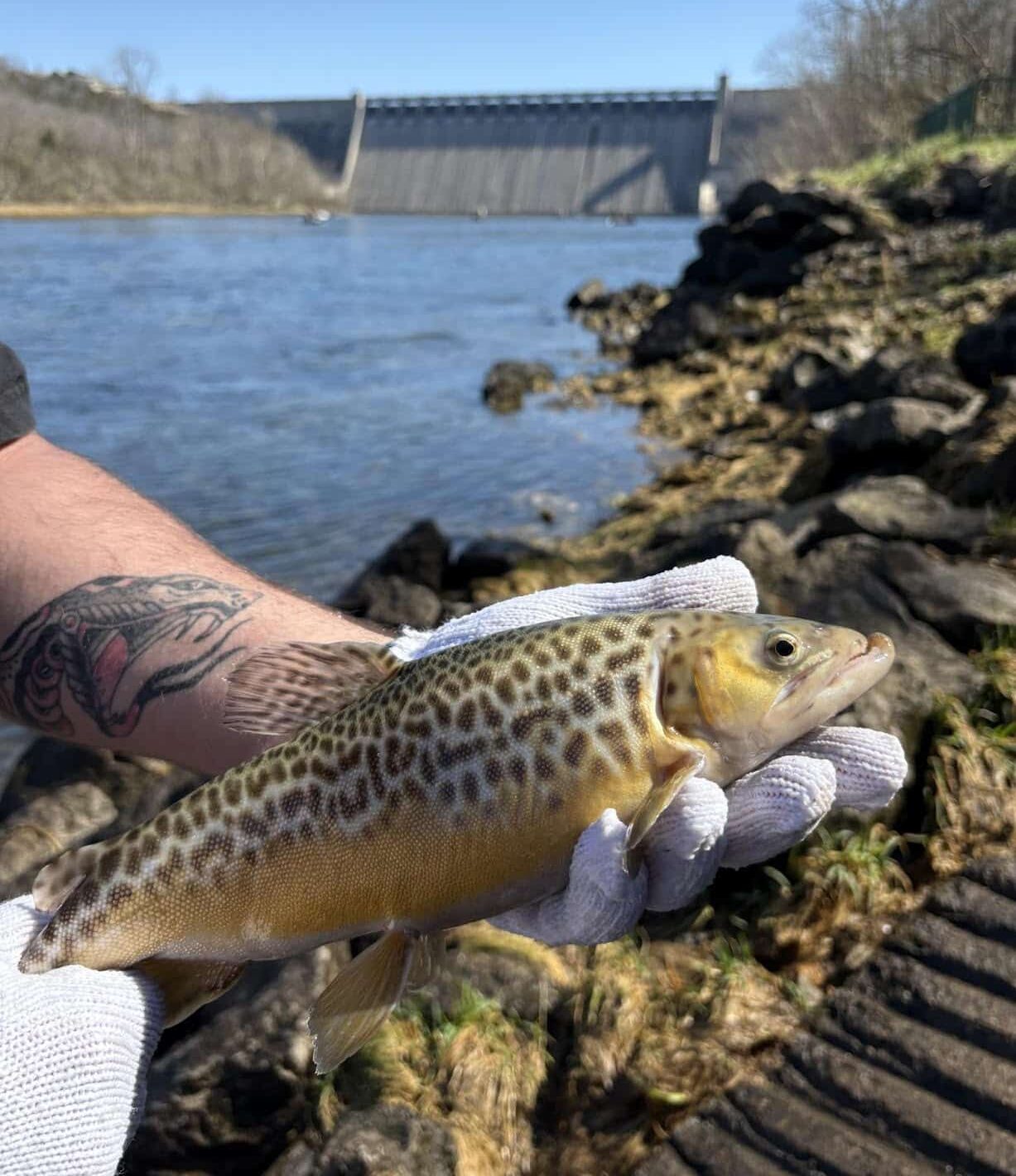
Catch a tiger by the tail(water)
Mar. 31, 2025
Subscribe to Our Weekly Newsletter E-mails
Don’t miss another issue. Sign up now to receive the AGFC Wildlife Weekly Newsletter in your mailbox every Wednesday afternoon (Waterfowl Reports are published weekly during waterfowl season and periodically outside the season). Fishing Reports arrive on Thursdays. Fill in the following fields and hit submit. Thanks, and welcome!

